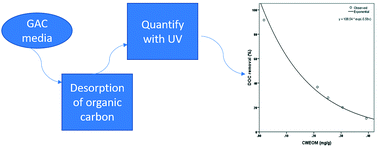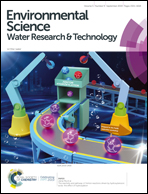Water extractable organic matter (WEOM) as an indicator of granular activated carbon (GAC) bed life and water quality outcomes in drinking water treatment†
Abstract
Granular activated carbon (GAC) is often used in drinking water treatment to remove dissolved organic carbon (DOC), taste and odour compounds, and organic micro-pollutants. As these chemicals are adsorbed onto the GAC surface, the area available for further adsorption decreases, meaning that the removal of target compounds decreases over time. Ascertaining the correct point to regenerate the GAC is a critical parameter in terms of both water quality performance and operational expenditure for the water company. Using a test case of a UK water treatment works with five GAC beds of varying age we show that current practices of using time-in-use are ineffective for optimal removal of DOC and disinfection by-product precursors. Our data show that assessment of the water extractable organic matter (WEOM) adsorbed onto the GAC can give an accurate indicator of both DOC removal (adjusted R2 = 0.985, p = 0.001, n = 5) and reduction in trihalomethane formation (adjusted R2 = 0.970, p = 0.001, n = 5). These results suggest that simple methods using equipment commonly available at treatment works could be adopted for rapid assessment of remaining GAC bed life.



 Please wait while we load your content...
Please wait while we load your content...